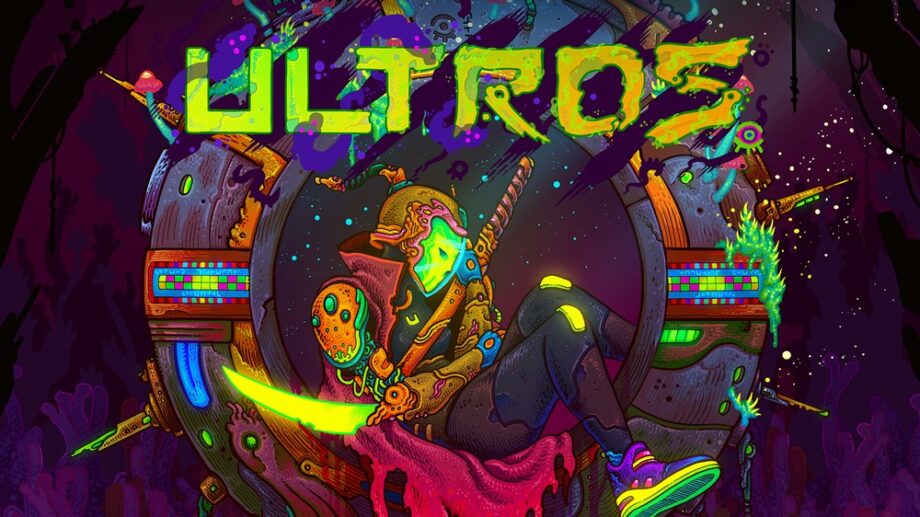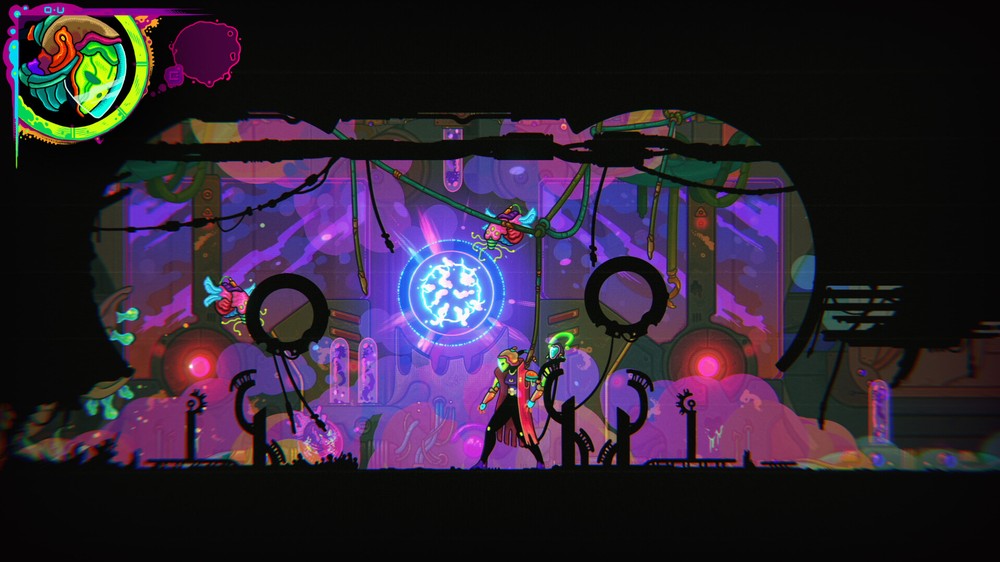Marketed as a metroidvania, Ultros contains the ability upgrades, the boss fights, and the large overworld map you come to expect from the genre. This psychedelic debut from developer Hadoque takes some of those aforementioned genre staples and turns them on their heads. Upgrades, which are normally reserved for the player, expand to the environment in forms of seeds. Throw in a time loop mechanic and an interesting meta-narrative and you get a game that isn’t afraid to experiment. It comes at a cost though as the game struggles to find a steady pace throughout its run time and is mired by some questionable quality of life decisions. It’s far from perfect, but I can’t help but admire the swings Ultros takes in its attempts to stand out.
Ultros maroons players on The Sarcophagus, a spaceship trapped in a Black Hole, teeming with lush forests, wildlife, and a demonic presence known as Ultros. Players will immediately be drawn in by the cosmic art style. El Huervo, of Hotline Miami fame, spares no line or color in depicting a once vibrant society. Ancient statues in the background tease at beings that once roamed the ship. Shrouded in beauty and mystery, exploring The Sarcophagus feels like taking a trip through the Shimmer, a la Jeff VanderMeer’s Southern Reach Trilogy. I was continuously sucked into the details in each new area. If any game were ever worthy of an artbook, Ultros would be at the top of my list. Not pulling any punches either is the original soundtrack, scored by Ratvader. It’s a string-heavy score that creates a sense of adventure, wonder, and dread with every pull of the bow. Anger of the Chalice from the tracklist is a flurry of violins and drums that no ear should miss.
Once pulled from your art-driven daze, players set out to find a way off The Sarcophagus. This quickly turns into a mission to awaken Ultros, which can only be done after releasing seven shamans from space cryo-sleep. It’s a straightforward set-up that drives a lot of the exploration. The biomes, while not the most diverse, do enough to stand out. From an alien day spa to a makeshift gameshow, there’s enough weirdness in each biome to add to the overall allure of The Sarcophagus. The wildlife encountered is a small mix of bugs, alien quadrupeds, and strange anomalies. I do wish there were just a bit more variety. Bosses are pushovers, but they look great and fit perfectly into their biomes.
Combat is light compared to other modern metroidvanias. Most fights you’ll find yourself simply swinging, dodging, and countering. Upon dying, wildlife drops food that gives players health and four different nutrients upon consumption. These nutrients can be used to unlock upgrades called cortex memories. Not just limited to combat abilities, cortex memories can also unlock traversal abilities and map upgrades. Tying upgrades to nutrients is a fresh take that differentiates Ultros from the currency driven upgrades of its modern counterparts.
Things start to get murky when you remember you are drifting through a Black Hole. Releasing a shaman gives you a device, called the extractor, which comes with useful functions for navigation, such as a thrust that launches you through the air, or a trimmer that cuts through thick plant life blocking your path. The usefulness of these functions is cut short though. With each released shaman, players must return to the center of the map to present the extractor to Ultros. This ends the current cycle and places players back in the beginning of the game minus the extractor and their cortex memories. The pain lessens a little when you realize you can lock some cortex memories in place between cycles. You also get the extractor back by returning to Ultros. These don’t change the fact that the game is brought to a screeching halt thanks to having to refetch your powers at the start of every new cycle. A fact the game is clearly aware of in later cycles as it starts bringing the extractor directly to you.
A major portion of Ultros is the planting of seeds around The Sarcophagus. There are a multitude of seeds that change how you can interact with the environment. One seed grows into a massive tree that you can climb to access hard to reach areas. Another seed grows into tall grass that speeds up your movement as you run across it, and also gives you the ability to run on walls. The seeds and the plants they grow into are easily the highlight of the entire experience. I found myself more excited about discovering new seeds than I ever was about any of the cortex memories. Plants also change between cycles by growing fruit and expanding. Opening your overworld map presents you with what seeds are planted where. It’s astounding the map tracks every plant. It’s one of those things where if you’re not paying attention, you can completely miss it, but once you’re aware of it, you can’t live without it. While I think you gain it too late, the extractor eventually gains the ability to dig up old seeds. Ultros is at its best, when the seeds are the stars.
Let’s talk about the Living Network. The Living Network is this stream the player can carry between the plants and machines to connect them. Carrying the Living Network to two separate save areas, creates an option to quick travel between those areas. Bringing the stream to a statue can open a sealed door or grant you some additional lore. Carrying the stream, you’ve only got so many steps to make a new connection before the current stream is broken off, making plant placement crucial. I love the Living Network and the way it ties into the meta-narrative of the game. Ultros explores the cycle of life and death, but also gets into generational change and the slow pace of progress. Spreading the Living Network, while not essential to finishing the game, is a true test of patience and is where Ultros really starts to show flashes of greatness. The one negative tied to the Living Network is that it’s only introduced halfway through the campaign.
Ultros has some quality-of-life issues that muck things up a bit. It’s a big misstep that a game so focused on wildlife and plants lacks any kind of bestiary or journal. The extractor does gain a scan function, but it’s near the end of the game, and the scan entries aren’t saved anywhere to be accessed later. The menu wheel that displays food and seeds, aside from the name, doesn’t give you any information to differentiate those items. I spent a lot of time guessing what a seed would grow into as I planted it. Sure, the game gives you an info screen upon obtaining a new type of seed or food, but I could not return to those screens later through the tutorials or menus.
Ultros is not a bad game, it’s just a bad metroidvania. Yes, you explore a large map, fight enemies, and gather upgrades, but the game at its core is about coexisting in a space, whereas the genre is more about dominating everything in your path. It’s taking tried and true territory and trying something new with it. I dig some of the stuff it’s doing, I just wish it was wrapped up in an experience that felt more constant.















